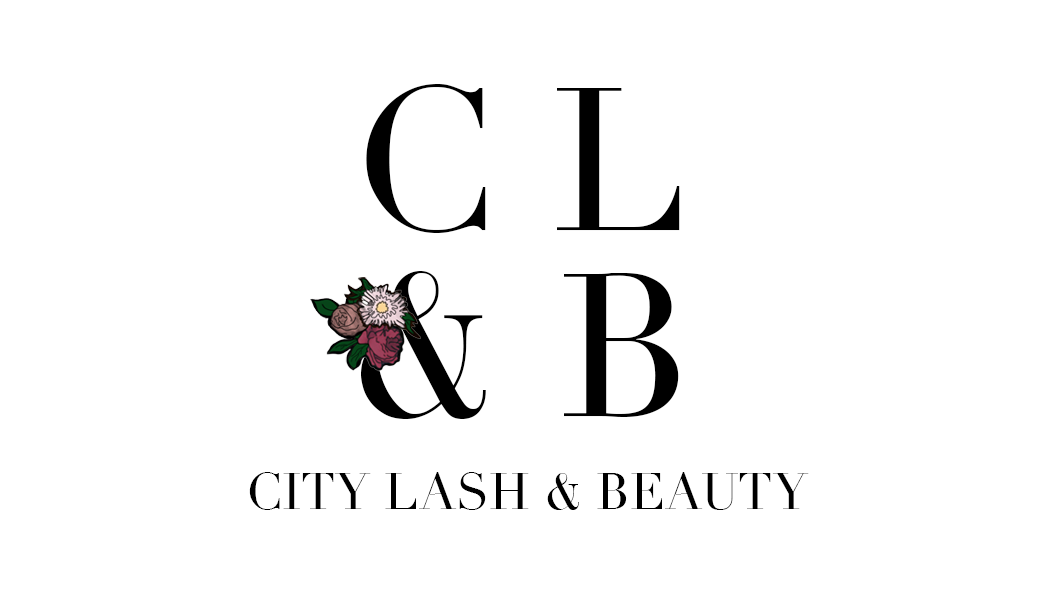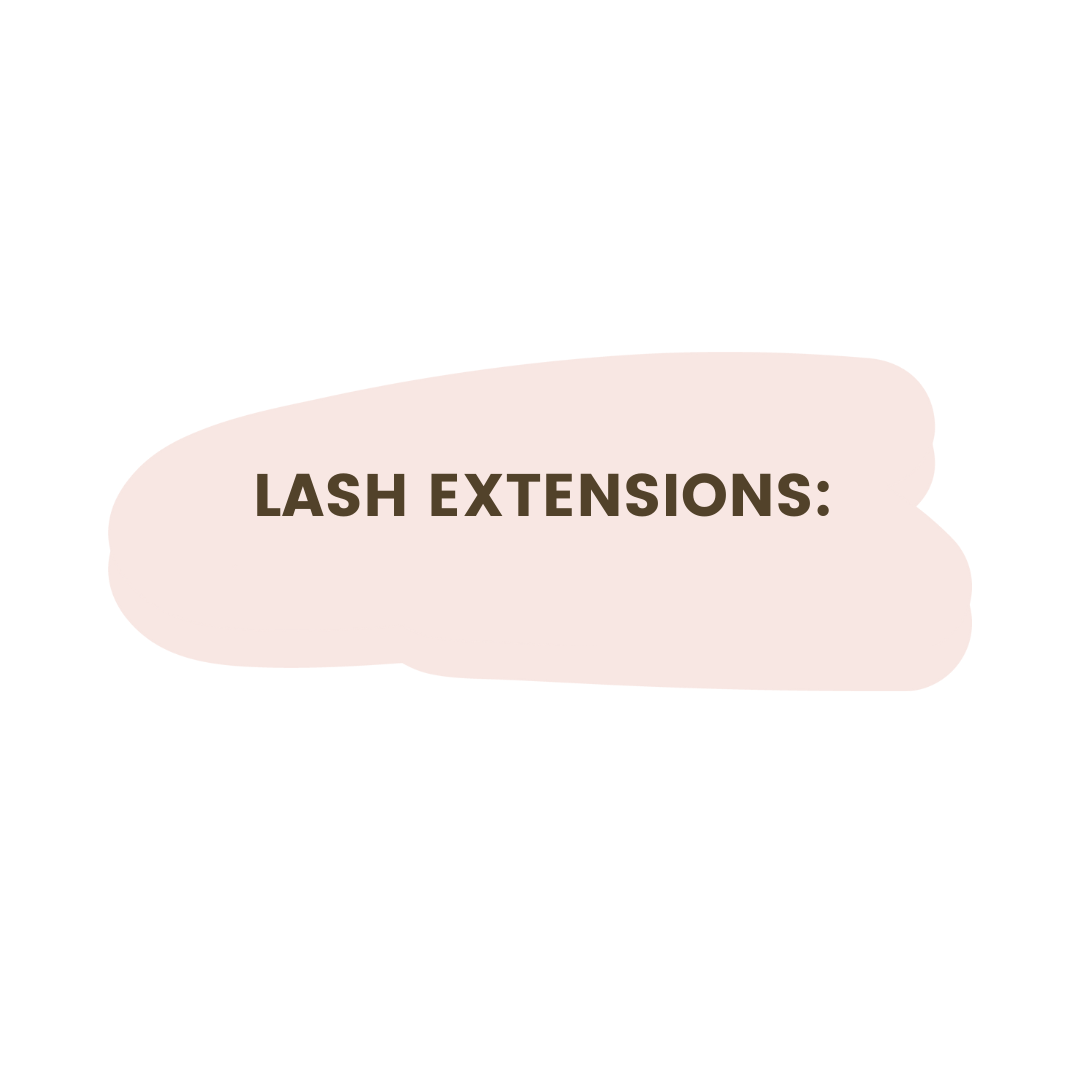Q: What are lash extensions? What kind of lashes do you use? We use top of the line lashes made of a synthetic mink and come in a variety of curls, lengths, and diameters. Depending on which style you choose, we either place a classic lash extension on your natural lash (the 1:1 method), or with volume lashes, we custom make volume fans, and are able to increase the fullness of your lashes while maintaining fluffiness and lightness. Hybrid lashes are a mixture of both classic and volume. Each style can be as “natural” or as “dramatic” as you’d like. The style you choose (classic, hybrid, volume, or mega) really depends on your consultation with your artist and what look you desire.
Q: How long will they last? And how long are the appointments? They last about 3-4 weeks (depending on your activity level and lifestyle). A full set takes anywhere from 2.5-3 hours and a fill takes 1-1.5 hours.
Q: Will lash extensions damage my natural lashes? Definitely not. When applied properly by a highly trained esthetician and certified lash artist, your natural lashes are completely safe. Several clients have been with us for 3+ years and their natural lashes are strong and long. In this field, many "lash artists" are not estheticians or certified artists and do not properly isolate your natural lash (which results in lashes glued together) or place very heavy lashes (we use the lightest weight lashes on the market).
Q: Can I still exercise? Swim? Get facials? Yes, but steam, excessive water, and oils do weaken the bond of the adhesive so if you are doing hot yoga everyday or swimming/wearing tons of sunscreen, etc. you may need to come in closer to 2-2.5 weeks instead of the usual 3-4 weeks. Not everyone is affected by steam/oil, it varies from person to person. If you do sweat heavily every day, please rinse your lashes with water after.
Q: Do I still have to wear mascara? No! That's the best part of lash extensions. You truly don't need mascara and will wake up every morning and feel awake and gorgeous and can head straight out the door (well, don't forget your coffee).
Q: Can I wear eye makeup? Yes. You can. Just make sure you remove it with an oil-free makeup remover.
Q: I don't have any natural lashes, am I still a good candidate? If you have very few natural lashes or even gaps in your lashes, you are a great candidate for lashes. Using volume lashes is probably your best bet because you can fill in the gaps and create a full lashline even if your natural lashes are sparse. It's an amazing transformation!
Q: Can I get lash extensions while pregnant? Yes, we have many pregnant mamas who like the ease of lash extensions while pregnant. We have pregnancy pillows to make your session comfortable and be sure to let us know you are pregnant so we can allot extra time for bathroom breaks during the session if needed!
Q: I’ve had an allergic reaction before, can I still get lash extensions? Give us a call about this. Allergic reactions are very rare and sometimes ‘sensitivities’ are confused with allergic reactions. We have many clients with ‘sensitivities’ and we have several techniques to work through that such as anti-allergy gels, barrier creams, washing the lashes during the process and after, etc.
Q: Who would be a great candidate for a last lift?
Our keratin-infused lash lift is for clients that are pleased with the length of their natural lashes but want a semi-permanent curled, enhanced mascara look. It is not recommended for chemotherapy clients. A lash lift is a great way to curl your lashes and give them the “lash extension” look without the maintenance.
Q: What should I avoid after my lash lift? Avoid getting your lashes wet for the first 24 hours as it will cause the lift to fall. Avoid steam rooms and saunas; overall, refrain from all heat. After 24 hours, you may go about with your daily routine.
Can I use mascara? Allow 24 hours before applying any type of product to your lashes. After 24 hours, you may apply mascara, eyeliner, eyeshadow, or any type of makeup products you desire; it will not affect the lashes.
Q: What is the process like? The process is very similar to eyelash extensions. your bottom lashes and top eyelids are covered with a gel pad. Your eyes are to remain closed during the entire process. Depending on the length of your natural lashes, a silicone rod (comes in 3 sizes - small, medium, and large) is placed on top of the eyelids to determine which size silicone rod best suits your lashes to achieve the best lift. Once the size is determined, the rod is placed onto the gel pad of the eyelids and a lash glue (water-soluble) is used to push the natural lashes back onto the rod - a lash setting solution is applied for 5-7 minutes on both sides. The setting solution then gets removed with a micro-swab and the lash neutralizer solution is applied on both sides for 5 minutes. during this process, the tinting process will take place after the neutralizer is removed. The tinting portion takes about 5-10 minutes.
Q: What are contraindications for Lash Lifts? We would love for you to have stunning lifted lashes, but there are certain circumstances where we may not be able to perform a lash lift. These are known as contraindications, where the treatment’s negative effects could outweigh the benefits.
We might not be able to go ahead with the Lash Lift treatment if:
You had a Lash Lift within the last 8 weeks. This is because it takes about 6-8 weeks for a Lash Lift to grow out so doing another one too soon may damage your natural lashes. For the health of your lashes, better to just wait and set your appointment for after this period. There might be an exception though. If you’ve had your lashes lifted elsewhere but the lashes haven’t lifted properly, you might be able to do a ‘remedial lift’ sooner than the 6-8 weeks. We’ll have to assess your lashes and let you know.
You are pregnant. If you’re in the first trimester, we won’t be able to perform the treatment as it has not been clinically approved for women who are pregnant within this period. After the first trimester though it’s fine. We still recommend a patch test to detect any possible reactions due to the hormonal changes.
You have had a history of previous allergic reactions to lash lifting. If you’re allergic to eyelash extensions you still might be able to do a lash lift because lash lifts don’t involve the use of adhesive.
You have had laser eye surgery in the previous six weeks. Within this period, your eyes are still in the healing process, and any additional eye treatment can cause irritation.
Your eyes are inflamed, have a stye or are infected. Your eye area needs to be completely healthy for any treatments to be safely applied.
You are on hormonal medication. For example accutane, thyroid medication. These types of medications make it hard to predict how effective the lash lifting solution will be so we don’t recommend it during this period to avoid disappointment.
Q: What is a brow lamination? Brow Lamination takes your unruly or thinning brow hair and smoothes it out while also lifting the hair in a more vertical direction. The end result is super smooth brows that look like you have brow gel on them.No matter what your brow concern is — gaps, thinning, overplucking, unruliness — brow lamination is an amazing solution and a great microblading alternative. It hides small gaps and gives the illusion of major hair growth. This is a noninvasive, temporary, but impactful way to fix brows in an affordable way.
Q: Am I a good candidate? If you have brow hair but you can’t see it or it’s light or thinning, you are an awesome candidate! You’d be surprised by how much brow hair you actually have and we can really give you a stunning result.
Q: Should I use a serum? A serum is a great idea! We carry Grande Lash and it helps fill in the ‘gaps’ and grows more hair for us to work with.
Q: How often do I come in for brow lamination? It is recommended to get a brow lamination every 8 weeks to allow the hair growth cycle to complete.
Q: What are the contraindications for brow lamination? A contraindication is a condition or factor that serves as a reason to withhold a certain medical treatment due to the harm that it would cause the client.
Pregnant or breastfeeding – Not recommended for pregnant women during the first trimester (please consult your physician)
Using any Vitamin A or Hydrocortisone products (Retinol / E45) – Do not use for 3 days either side of the treatment.
Psoriasis/Eczema – Not suitable for treatment if in the treatment area
Alopecia -Not suitable for treatment
Moles in the treatment area – Not suitable for treatment.
Recent Permanent Make up (Bermanent make-up, Microblading, Tattoo, etc Must wait 4-6 weeks after 2nd procedure.
Sunburn on or around the brow area - Not suitable for treatment
Ultra-Sensitive Skin - Not suitable for treatment
Recent Anti-Wrinkle Injections or Fillers – not suitable for treatment.
Medications: Blood thinning, antibiotics (Must wait 2 weeks)
Eyelift – Must wait 4 to 6 months after the operation and a letter from GP stating you are suitable for treatment must be obtained
No self-tanning products should be used on the face for one week prior to treatment.
Cuts/abrasions/inflammation/swelling in or around the brow area
Herpes simplex/eye infections/ folliculitis – Not suitable for treatment whilst infected
Roaccutane (within the last 12 months)
Excessive Allergies – Not suitable for treatment
Recent scar tissue – Not suitable for treatment
Trichotillomania – Not suitable for treatment
Blepharitis – Not suitable for treatment
Haemophillia – Not suitable for treatment
Cancer – The brows need some extra TLC and babying during chemo and the recovery period, which varies from client to client. It’s important not to put any extra stress on you brows. It’s best to refrain from treatment during chemotherapy, and several months after the your last treatment, as the brows are still susceptible to the effects of the drugs. Ideally, you’ll want to wait until the natural brows are less fragile. A letter from your Oncologist stating they are happy for you to receive treatment should be obtained.
Q: What is dermaplaning? Dermaplaning is a procedure that exfoliates your skin and gets rid of dirt and vellus hair, better known as “peach fuzz.”
Q: What are the benefits of dermaplaning? One of the most commonly cited benefits of this treatment is the rested, rejuvenated appearance it gives patients. The skin on the face takes on a smoother and more youthful look. It also exfoliates the skin and removing the ‘peach fuzz’ helps products absorb better.
Q: How often should I get dermaplaning? Most clients should dermaplane about once a month for ideal results. Since the body naturally replaces skin cells each month, this ensures the old cells are removed and new, healthy skin cells are visible. In some cases, more or less frequent visits may be recommended based on the client’s specific needs.
Q: What are the contraindications for Dermaplaning?
Allergy to nickel
Current or recent use of accutane, eczema, dermatitis, malignant skin tumors, open lesions, lupus, active herpes infection, sunburn and keratoses.
Any Cancer therapy (chemotherapy, radiation)
Blood thinners
Waxing/threading or use depilatory creams for 7 days prior.
Cosmetic injections for 2 weeks before and after treatments.
Refrain use of Tretinoin, Retin-A, Renova, Differin, Tazorac, Avage, EpiDuo, Ziana and high-percentage AHA and BHA products for approximately 7 days prior to treatment. Consult your Physician before temporarily discontinuing use of any prescription medications.




